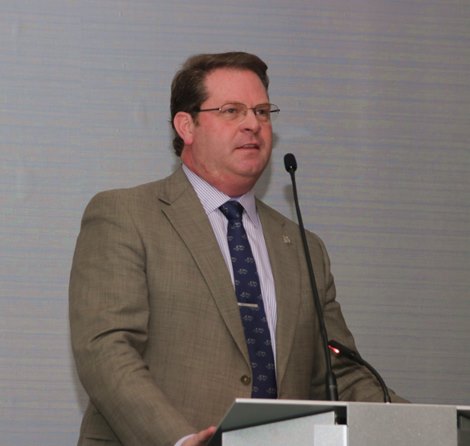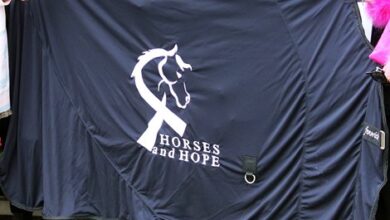Hamelback: Issues of Unsoundness Also Start at Farms

Speaking on a variety of topics during a meeting of track superintendents June 13 at Horseshoe Indianapolis, National Horsemen’s Benevolent and Protective Association CEO Eric Hamelback encouraged the industry in its search to identify issues contributing to unsoundness and breakdowns to examine the Thoroughbred breeding and sales markets.
He criticized the breeding industry as being too focused on the commercial market instead of breeding a durable racehorse and for relying on corrective surgeries performed on horses before a sale without concern about the long-term effects on durability. He said these surgeries should be treated no differently than any other “pre-existing condition” a racehorse might have. He also noted how breeders are not currently funding the Horseracing Integrity and Safety Authority, though they are “Covered Persons” under HISA.
Hamelback’s comments come at a time of heightened awareness about equine safety after at least 13 Thoroughbred fatalities this spring at Churchill Downs. In early June, racing in Kentucky was moved from Churchill Downs to Ellis Park while track officials and regulators continued to evaluate why the spike in fatalities at Churchill Downs occurred. Training has continued at Churchill Downs, where many horsemen stable their horses from spring through late fall.
Hamelback said at the meeting that he doubted the evaluation of fatalities would find “definable points that link them all together.” He encouraged attendees of the meeting, known as Track Superintendent Field Day, to examine the losses with a step-by-step approach, like peeling back layers of an onion.
Hamelback, who previously was general manager of Frank Stronach’s Adena Springs Farm in Central Kentucky, where he and his staff there raised numerous Breeders’ Cup winners, asked attendees where the high-volume starters of past eras can be found today, a suggestion that they are not around.
Video
“Because I’m telling you as a longtime farm manager, issues of unsoundness do not just start at the racetrack. … It also starts at the farm,” Hamelback said.
In a follow-up interview with BloodHorse June 16, Hamelback said his comments at the meeting were intended to encourage collective thought.
He leads an organization with approximately 29,000 owner and trainer members throughout the United States and Canada, according to the National HBPA website.
“I’m not trying to point fingers at anyone but at the end of the day, there needs to be some accountability on all levels if we’re going to try to shape what we hope is uniformity and what’s best for the industry going forward,” he said.
The Jockey Club, whose subsidiary The Jockey Club Information Systems co-owns BloodHorse with the Thoroughbred Owners and Breeders’ Association, declined comment on Hamelback’s remarks. Upon request, TJC provided statistical information on the breed dating back to the early 1990s.
Much has changed in the industry over that time period—notably smaller foal crops, fewer owners breeding to race, and several studies that indicate a narrowing genetic diversity in the breed that has been linked to the era of elite stallions breeding large books of 150 mares and more.
TJC sought to head off problems that can arise with declining genetic diversity—an increased concentration of mutations that might potentially affect fertility or performance—by announcing in 2020 a rule that would eventually limit stallion books to 140 mares annually starting with stallions born in 2020 or later in a given year. The move proved divisive, with some breeders and farms supporting it and others viewing it as infringing on free-market capitalism. The rule was rescinded in 2020 before implementation after court and legislative challenges.
Up until now, however, data provided by TJC does not indicate an increase in unsoundness strictly related to breeding decisions. Foals continue to start at the rate they once did on a percentage basis. Foal crops from 2008-17 have a marginally higher start rate (almost 74%) compared to those from a decade earlier (just over 71%). The percentage of foals racing at age 5 and up is 32% for foal crops from 2008-17, also just above those from prior decades.
Some analysts believe that if the breed were not as sturdy as some in the industry claim then those figures would be in decline.
Yet horses are racing less often compared to prior eras, and horsemen are often reluctant to run their animals on short rest. Kentucky Derby (G1) winner Mage , trained by Gustavo Delgado, was the only horse to return from the Derby to compete in the Preakness Stakes (G1) two weeks later. Mage did not run in the Belmont Stakes (G1) three weeks after his defeat in the Preakness, though that race’s winner, National Treasure , did.
The perception that not enough horses are competing through the three-race series, which runs over five weeks, has renewed calls to spread out the Triple Crown.
The trend of horses not being run as often as they once did is not limited to elite racehorses. According to the TJC-supplied data, the average starter from the foal crop of 2008-17 raced 17.7 times, down from 18.4 in 1998-2007 and from 20.2 during a 1993-2002 time period that overlapped with the 1998-2007 grouping in the TJC data.
Whether that is due to the durability of the breed, changes in the sport’s economics, shifts in training styles and management, or other factors has been debated for years.
As far back as 2008, renowned equine surgeon Dr. Larry Bramlage addressed the Thoroughbred breed, corrective surgeries, and a commercial sales shift in the breeding marketplace at The Jockey Club Roundtable. At the time he stated, “There is no inclination toward decreased probability of racing” due to the aggressive surgical management of yearlings.
Others, such as Hamelback, disagree. “The pre-existing injuries that really are being described in fatalities are remodeling dysfunction where the bone at the cellular level doesn’t operate correctly. You can’t find it with conventional methods,” he said at Track Superintendent Field Day.
Though the National HBPA has battled with the Horseracing Integrity and Safety Authority in court over the legality of the Act that authorized HISA, Hamelback said he had “good, positive conversations” with HISA CEO Lisa Lazarus on some of the industry issues he addressed at the meeting and with BloodHorse this week.
“We have an issue with the constitutionality of the Act, but we’re certainly trying to help formulate regulations and if we can have some input, great. And if the Act is unconstitutional, we hope something better comes out on the other side,” he told BloodHorse.
He said he is addressing industry change from a consumer-protection angle, such as “having that ability to know what’s in a (sale) yearling’s system.”
Hamelback said Friday he would like to see The Jockey Club’s Equine Injury Database publicize fatalities by monitoring horses that had corrective surgery, those exiting sales filtered by ages at their time of sale, and other factors. “There are some nuances there that I think could help or prove if (something is) not an issue or disprove a concern,” he said.
Equine fatalities have steadily decreased across the industry after the formation of the Equine Injury Database. It publishes overall figures as well as fatality statistics by a horse’s age, surface of competition, and by specific track.
Asked for his reaction to Hamelback’s remarks at Track Superintendent Field Day, John Sikura, who owns Hill ‘n’ Dale Farm in Central Kentucky, commented, “Everyone needs to be contributory to fund initiatives that help the breed and support vigilance regarding soundness and the welfare of the horse.
“As a commercial breeder and someone who also races my goals are the same,” he continued. “I wish to breed a sound horse with a goal to producing a superior racehorse that is viable in the sales ring or on the racetrack. Any suggestion that these goals are not the focus of breeders is inaccurate in my opinion. Furthermore, any corrective surgeries or preventive measures we take are to present a pristine, load-balanced individual that has the best chance to survive the rigors of racing.”

John Sikura
He noted that all three winners of the Triple Crown races “were sold at public auction and represent what we all achieve to do, which is to breed a yearling that survives the demands of the racetrack and makes their breeder proud.
“Assumptive guessing as to why horses are not as durable as those of the past is just that. There are many other plausible explanations such as ‘super trainers’ only starting horses that are likely to win, trainers wanting to maintain high win averages, belief that horses elicit their best performance given plenty of time between races, and intolerance of owners to give their horse ‘an out’ like the old days. Permissive medication and economics also contribute.
“Today’s society is intolerant of racing breakdowns even though rare and most often not preventative. We must continue to do all we can to prevent such and not take sides looking for the villain when they occur.”
Hamelback said Friday many factors have contributed to a decline in starts, “But I don’t think to this point—at least from a conscious effort that everybody else sees—that we’re really having somebody kind of monitor the strength of the breed.
“Now how can that be done? I’m not gonna say that I know off the top of my head, I’m putting it out there as an opportunity if we’re trying to reshape and improve the industry. We can’t just assume that the industry is going south because ‘said trainers’ are doping horses. That’s the narrative that I’m trying to turn around because it’s killing us in the press.”
Carrie Brogden, a Kentucky breeder, owner, and consignor who operates Machmer Hall Thoroughbreds near Paris, Ky., agreed with elements of comments made by both Sikura and Hamelback. She backs Hamelback’s desire to see more horses bred to race, but is not aligned with him on every issue, she said.
Brogden is opposed to Lasix, a diuretic in the midst of a phase-out as a race-day medication in many parts of the country, most often prohibited in stakes races and 2-year-old races. Lasix is widely supported by trainers as a means to control respiratory bleeding in horses, but its critics, which include a number of breeders, argue it is overused and performance-enhancing by causing horses to retain less water and compete at a lighter weight. Some observers believe this weight loss results in horses needing more recovery time.
Brogden believes stallions, more so than mares, have the most potential to shape the breed, owing to covering so many mares in a given year.

Carrie Brogden
Once young horses go to auction, the commercial Thoroughbred market is dictated by what owners find appealing, she said. Commercial breeders want to put into the marketplace what owners desire.
The lack of commercial appeal for certain sire lines or horses that were later to develop than others has also influenced the breed, she said, mentioning retired racehorses such as Mind Your Biscuits , Drefong , and Hot Rod Charlie —none of whom were by hot commercial sires in the United States—that were purchased to go to stud in Japan.
“Japanese breeders have embraced American speed and they’ve really taken advantage of what we have failed to do,” she said.
Thirty-six percent of the 2020 foal crop were sold as yearlings, according to The Jockey Club Fact Book, a number expected to continue to rise. It ranged from 17-19% with foal crops from 1987-92 before climbing steadily in 30 years since.
“I made the comment in 2013 that if breeders don’t start breeding to race and stop breeding for the commercial market, this industry is in trouble,” Hamelback said Tuesday, noting he was proud to have received the support of owner/trainer/breeder John Nerud, a Hall of Famer. Nerud died in 2015.
“I believe that this industry must be focused on improving the breed to make it a safer environment for all of us and ultimately, the industry to be safer, understanding we can’t mitigate every risk,” Hamelback concluded in his Tuesday remarks. “But if we peel back the layers and find out where we need to begin, that’s what will make us grow into the future.”
Eric Mitchell provided additional reporting for this story.




